接种芽孢杆菌可改善伞形科植物幼苗的根系结构、气体交换和养分利用效率
IF 3.9
2区 农林科学
Q1 HORTICULTURE
引用次数: 0
摘要
在森林物种中接种促进生长的根瘤菌是一项不断发展的技术,它不仅能改善生长,还能提高最终质量,从而改变原植物的健壮性和抗性。本研究的目的是评估接种了促生长根瘤菌芽孢杆菌 CCMD862 的苍术幼苗的生长、根系结构、气体交换、叶绿素 a 荧光、叶绿素含量和养分利用效率。生长促进实验在温室中进行,使用的是 Corymbia torelliana x Corymbia citriodora 的杂交克隆幼苗。接种可促进气体交换、叶绿素荧光、养分利用、生物量变量以及与对照组相比的所有根系结构参数。生物计量和生物量的改善导致 DQI 增加,总体生长促进率比对照植物高 30%。芽孢杆菌 CCMD862 菌株能对苣苔幼苗进行生物刺激,促进根系发育、光合装置增大、养分吸收和有效利用,从而培育出健壮的幼苗。本研究获得的结果必须在田间条件下得到证实,未来开发的接种剂可帮助苍耳子生根,有助于降低田间死亡率并获得均匀的商业价值。本文章由计算机程序翻译,如有差异,请以英文原文为准。
Inoculation of Bacillus sp. improves root architecture, gas exchange and efficiency of nutrient use in Corymbia seedlings
The inoculation of forest species with rhizobacteria growth promoters an increasing technology capable of improving the growth and also the final quality contributing to change robust and resistant originals. The objective was to evaluate growth, root architecture, gas exchange, chlorophyll a fluorescence, chlorophyll content and nutrient use efficiency in seedlings of Corymbia inoculated with the growth promoting rhizobacteria Bacillus sp. CCMD862. The growth promotion experiment was carried out in greenhouse, using hybrid clonal seedlings of Corymbia torelliana x Corymbia citriodora. The experimental design was CRD with 2 treatments (control and rhizobacteria Bacillus sp. CCMD862) with 5 replications for each treatment and 5 replicates per treatment (Bacillus sp. CCMD862 and Control - not inoculated). noculation promoted gains in gas exchange, chlorophyll fluorescence, nutrient use, biomass variables and in all root architecture parameters in relation to control. Biometric and biomass improvements resulted in higher DQI and a global growth promotion rate 30 % higher than control plants. The strain Bacillus sp. CCMD862 is able to biostimulate seedlings of Corymbia favoring the development of the root system, gains in the photosynthetic apparatus, increases in absorption and efficient use of nutrients that resulted in robust seedlings. The results obtained in this study must be confirmed in field conditions and the future development of an inoculant could assist with rooting in Corymbia, helping to reduce mortality in the field and obtain homogeneous commercial
求助全文
通过发布文献求助,成功后即可免费获取论文全文。
去求助
来源期刊

Scientia Horticulturae
农林科学-园艺
CiteScore
8.60
自引率
4.70%
发文量
796
审稿时长
47 days
期刊介绍:
Scientia Horticulturae is an international journal publishing research related to horticultural crops. Articles in the journal deal with open or protected production of vegetables, fruits, edible fungi and ornamentals under temperate, subtropical and tropical conditions. Papers in related areas (biochemistry, micropropagation, soil science, plant breeding, plant physiology, phytopathology, etc.) are considered, if they contain information of direct significance to horticulture. Papers on the technical aspects of horticulture (engineering, crop processing, storage, transport etc.) are accepted for publication only if they relate directly to the living product. In the case of plantation crops, those yielding a product that may be used fresh (e.g. tropical vegetables, citrus, bananas, and other fruits) will be considered, while those papers describing the processing of the product (e.g. rubber, tobacco, and quinine) will not. The scope of the journal includes all horticultural crops but does not include speciality crops such as, medicinal crops or forestry crops, such as bamboo. Basic molecular studies without any direct application in horticulture will not be considered for this journal.
 求助内容:
求助内容: 应助结果提醒方式:
应助结果提醒方式:


